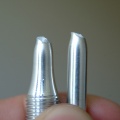Gemstone based metamaterial
Simply by nanostructuring abundant elements they can (in the vast majority of cases) replace the scarce elements that are needed today. In fact the one single element carbon alone is sufficient to replace almost all other materials.
|
tougher than metals |
The topic here are the base materials for all the products of gem-gum technology.
- Up to more general definition: Metamaterial or Mechanical metamaterial
- To: Gemstone like compounds which serve as the base-materials for gemstone based metamaterials.



Definition
A gemstone based metamaterial (or diamondoid metamaterial or gem-gum for short):
- 1) consists out of one (or a few) gemstone like base materials
that means compounds that are suitable for advanced atomically precise technology - 2) has a for the human senses imperceptibly small structuring.
This structuring is usually formed by complexly interlocking crystolecules and microcomponents. - 3) optional: Has somehow interlocking crystolecules or microcomponents with some sort of mechanical function (bearing interfaces present and critical for function). This third point is only added here to delineate more clearly (high level) gemstone based metamaterials from low level gemstone metamaterials.
The structuring gives the resulting material properties that are not native to the base material. In fact the properties of the gemstone metamaterial can be polar opposites of the gemstone base material.
For instance: The base materials usually have gemstone properties but a metamaterial made from these base materials can behave like rubber for human perception. The them "gem-gum technology" sometimes used here on this wiki refers to that fact.
Since there is a hyper-gigantic space of possible structurings there's an equally sized space of novel (mechanical) material properties that range from simple improvements over uncommon/unfamiliar material properties to outright alien stuff.
Countering resource scarcity
The wide range of material properties is achievable with just one (or a few) diamondoid base materials that contain just one (or a few) abundant elements. Thus gem-gum Technology has the potential to solve large parts of today's (2016) looming civilization problem of resource scarcity.
Specifically advanced elasticity emulating gemstone based metamaterials (gem-gum) makes mining after less abundant alloying metals for the most part unnecessary.
Contents
[hide]- 1 Definition
- 2 Countering resource scarcity
- 3 Gemstone based metamaterials as foundation for advanced atomically precise gem-gum Products
- 4 Tensile strength
- 5 Robustness of AP microscale machine systems
- 6 The limits of metamaterials
- 7 Gemstone metamaterial ≠ utility fog !!
- 8 When sharp borders between base-material and metamaterial blur
- 9 When sharp borders between active nanomachinery and metamaterial blur
- 10 Lopsided volume ratio in metamaterial type usage
- 11 Examples
- 12 Notes
- 13 Related
- 14 External links
Gemstone based metamaterials as foundation for advanced atomically precise gem-gum Products
Diamondoid metameterials form the necessary basis for the yet speculative advanced applications of the goal technology level.
These highly complex applications will only become possible through the smart combination of the set of newly available metamaterials with novel properties.
For a list of potentially possible gemstone based metamaterial go to the
main article: "List of potential gemstone based metamaterials"
Tensile strength
A gemstone based metamaterials tensile strength cannot exceed the tensile strength of the (flawless) base material. Thus for more demanding applications a good base material with decent tensile strength may be preferable over something that is weaker but better degrading.
Still in a gemstone based metamaterial the crystolecules made out of this base material are (on average) flawless, while a big macroscopic thermodynamically grown (synthetic or natural) gemstone is not. Thus the metamaterials tensile strength actually can exceed the tensile strength of the base material in the flaw-rich gemstone form we can inspect today.
Robustness of AP microscale machine systems
- Natural background radiation won't hit a small part of a system for decades on average. Bigger systems can retain functionality reliably through redundancy.
- The digital nature of AP building blocks (copies have completely identical bond topology) makes them self correct their alignment in spite of thermal expansion. This allows for highly scalable system design. The same can be seen in digital electronics mechanical flaws up to 5% in length of chip structures and similar electrical flaws in voltage are self correcting.
- Effect of lack of defects - diamond gum:
Substances that are normally very brittle can take enormous strain (in the two digit percent range) when they're completely free of defects. With APM making completely defect free microscopic parts is easy. When those microscopic parts are combined back together in a smart way that prevents crack propagation (e.g. with interlocking shapes) this property can be retained into the macroscopic size range. See "emulated elasticity" for more details.
Related: Acceleration tolerance
The limits of metamaterials
Some combinations of material properties are just not permitted by physical law and can thus not or only to a small degree emulated by metamaterials.
Examples for this are:
- non polarizing optical transparency of thick plates is incompatible to isotropic electric conductivity
(TODO: check in how far that is true) - very high thermal isolation conflicts with very high compressive material strength
macroscale layerd designs are a straighrforward workaround though. (E.g. needed for Venus surface probes.)
Gemstone metamaterial ≠ utility fog !!
(Specialized diamondoid metamaterials - vs - general purpose utility fog)
Utility fog could be considered a very complex high level metamaterial that emulates elasticity (and more). But since it has the maximum possible degree of general purpose capabilities it is not optimized for any specific purpose.
Instead of going the general purpose route which takes high design effort. One can:
- use diamondoid metamaterials that are much simpler to design (and maybe simpler to build too)
- introduce complexity instead to highly optimize for one specific application (e.g. street pavings, medium movers, ...).
- do something in-between those two extremes
When sharp borders between base-material and metamaterial blur
(diamondoid metamaterials - vs - diamondoid compounds)
Note that there is a grey zone between diamondoid compounds and diamondoid metamaterials where it might not be 100% clear in which class they belong. In this grey zone there live e.g. compounds that including vacancies that are distributed in a checkerboard pattern. Is this just a different crystal structure (another polymorph or neo-polymorph in an pseudo phase diagram) or just a metamaterial.
One could call these cases low level metamaterials. A short note on low level diamondoid metamaterials can be found on the page describing diamondoid materials.
When sharp borders between active nanomachinery and metamaterial blur
There are many many very complex nanomachinery systems that go beyond passive ans simple structures. It is unclear at which pouint calling these metamaterials no longer makes sense. Examples:
- chemomechanical converters and other energy converters
- muscle motors
- medium movers
- infinitesimal bearings
- More complex elasticity emulation with chemosprings
Lopsided volume ratio in metamaterial type usage
Due to the very high power densities (see here) that can be handled with diamondoid metamaterials,
metamaterials for energy conversion (motors/generators) and transmission (infinitesimal bearings,...) will in most cases only take up a small fraction of a products volume.
Leaving space for simpler design, more other functionality (e.g. data-storage) or allowing for highly collapsible design that get their shape by inflation with pressurized air.
(Related: mixing an meshing of various types of microcomponents)
Examples
Elasticity emulating gemstone based metamaterials
When one connects microcomponents in advanced nontrivial ways to create a metamaterial that is capable of emulation of elasticity, then one has reached the point where mechanical metamaterials really begin.
Note: This must not be confused with utility fog (which targets ultra general purpose capabilities at the expense of performance).
With elasticity emulation the nanoscale unbreakability properties of crystolecules (and microcomponents) are to a degree lifted up all the way to the macroscale.
This gives cheap materials with ...
- enormous toughness lying way beyond all metallic alloys in existence and ...
- unlike most metals corrosion resistance is at the level of the base material: the chosen gemstone.
Getting well designed gem-gum materials to chip of small splinters (e.g. attack by hardened saw-blade) will probably be almost impossible.
Note that this combination of material properties has not only positive sides though. Two obvious concerns are:
- Degradability is often a desired property. There are lots of gemstones that do degrade though (e.g. periclase MgO is slightly water soluble) so it's a matter of choosing the right material for the right application.
- Military misuse.
Notes
Advanced gemstone based products of productive nanosystems can be either be
- small scale reversibly recomposable or
- large scale monolithic
Which of the two it is depends on the specific design of the nanofactory.
Nanofactories capable of making monolithic designs seem
- harder to design and
- maybe less desirable
Less desirable because they are less frienldy for reuse and recycling.
Harder because they'd require large open PPV vacuum volumes (or some exotic sealing strategies).
See: vacuum handling
Small scale reversible recomposability requires
that crystolecules are not irreversibly welded together beyond a certain scale.
E.g. not beyond the scale of microcomponents.
Wikipedia's older definitions for metamaterials in (2014) did not mention mechanical metamaterials.
As of (2016) mechanical metamaterials seem to gain more attention.
A short section about them (structural metamaterials) has been added.
according to wikipedia
Related
- Levels of metamaterials
- Digital control over matter
- The defining traits of gem-gum-tec
- Stiffness
- Superelasticity
- High pressure
- Natural color of gem-gum products
- Metamaterial more generally
- Mechanical metamaterial
- Low level gemstone metamaterial
- Reasons for APM – There's a section about "new materials" and how it leads to problem solving opportunities.
- Likely visual appearance of gem-gum products
External links
Diamondoid metamaterials allows to reach spots in the Ashby plot (density vs tensile strength) that are not accessible by non AP means of production.
- Pictures of Ashby plots on wikimedia commons: saturated-pixelgraphic; vectorgraphic; a scan of a detailed version
- Wikipedia(en): Selecting the best material overall
- Wikipedia(de): Spezifische Festigkeit

